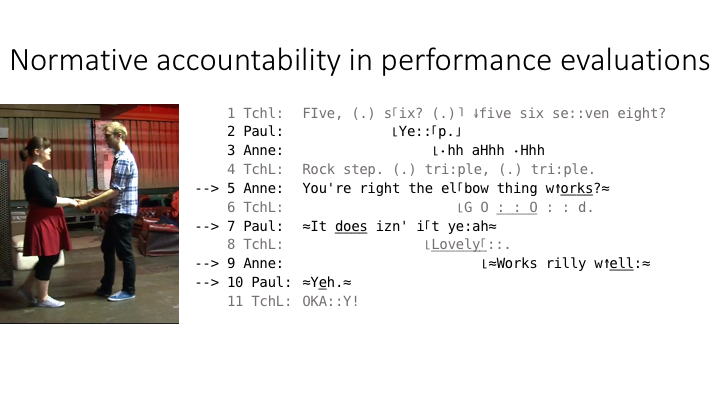Here these are the references for my talk on terminal assessments and performance evaluations in a partner dance workshop at LANSI 2017.
I’ve given up trying to fit them all onto one slide at the end – so here they are on this web page. A recording of the talk is to follow – here’s one of the slides for now:

References
- Albert, S. (2015). Rhythmical coordination of performers and audience in partner dance. Delineating improvised and choreographed interaction. Etnografia E Ricerca Qualitativa, 3, 399–428. https://doi.org/10.3240/81723
- Antaki, C. (2002). “Lovely”: Turn-initial high-grade assessments in telephone closings. Discourse Studies, 4(1), 5–23. https://doi.org/10.1177/14614456020040010101
- Antaki, C. (2000). “Brilliant. Next Question…”: High-Grade Assessment Sequences in the Completion of Interactional Units. Research on Language & Social Interaction, 33(3), 37–41. https://doi.org/10.1207/S15327973RLSI3303_1
- Broth, M., & Mondada, L. (2013). Walking away: The embodied achievement of activity closings in mobile interaction. Journal of Pragmatics, 47(1), 41–58. https://doi.org/10.1016/j.pragma.2012.11.016
- Broth, M., & Keevallik, L. (2014). Getting Ready to Move as a Couple: Accomplishing Mobile Formations in a Dance Class. Space and Culture, 17(2), 107–121. https://doi.org/10.1177/1206331213508483
- De Stefani, E., & Mondada, L. (2013). Reorganizing Mobile Formations: When “Guided” Participants Initiate Reorientations in Guided Tours. Space and Culture, 17(2), 157–175. https://doi.org/10.1177/1206331213508504
- De Stefani, E., & Gazin, A.-D. (2014). Instructional sequences in driving lessons: Mobile participants and the temporal and sequential organization of actions. Journal of Pragmatics, 65, 63–79. https://doi.org/10.1016/j.pragma.2013.08.020
- Garfinkel, H. (1967). Studies in ethnomethodology. America. Englewood Cliffs, New Jersey: Prentice-Halll.
- Goodwin, C., & Goodwin, M. H. (1992). Assessments and the construction of context. In C. Goodwin & A. Duranti, C. Goodwin & A. Duranti (Eds.), Rethinking context: Language as an Interactive Phenomenon (Vol. 11, pp. 147–189). Cambridge: Cambridge University Pressess.
- Harness Goodwin, M., & Goodwin, C. (1986). Gesture and coparticipation in the activity of searching for a word. Semiotica, 62(1–2), 51–75.
- Keevallik, L. (2010). Bodily Quoting in Dance Correction. Research on Language & Social Interaction, 43(4), 401–426. https://doi.org/10.1080/08351813.2010.518065
- Keevallik, L. (2013). Here in time and space: Decomposing movement in dance instruction. In P. Haddington, L. Mondada, & M. Nevile, P. Haddington, L. Mondada, & M. Nevile (Eds.), Interaction and Mobility: Language and the Body in Motion (pp. 345–370). Berlin/Boston: Walter de Gruyter.
- Oshima, S., & Streeck, J. (2015). Coordinating talk and practical action: The case of hair salon service assessments. Pragmatics and Society, 6(4), 538–564. https://doi.org/10.1075/ps.6.4.04osh
- Pomerantz, A. (1984). Agreeing and disagreeing with assessments: Some features of preferred/dispreferred turn shapes. In J. M. Atkinson & J. Heritage, J. M. Atkinson & J. Heritage (Eds.), Structures of social action: Studies in conversation analysis (pp. 57–102). Cambridge: Cambridge University Press.
-
Schütz, A. (1951). Making music together: A study in social relationship. Social Research, 18(1), 76–97.
- Stivers, T., & Rossano, F. (2010). Mobilizing Response. Research on Language & Social Interaction, 43(1), 3–31. https://doi.org/10.1080/08351810903471258
- Thompson, S. A., Fox, B. A., & Couper-Kuhlen, E. (2015). Grammar in Everyday Talk: Building Responsive Actions. Cambridge: Cambridge University Press,.
- Wiggins, S., & Potter, J. (2003). Attitudes and evaluative practices: Category vs. item and subjective vs. objective constructions in everyday food assessments. British Journal of Social Psychology, 42(4), 513–531. https://doi.org/10.1348/014466603322595257
-
Weeks, P. (1996). Synchrony lost, synchrony regained: The achievement of musical co-ordination. Human Studies, 19(2), 199–228. https://doi.org/10.1007/BF00131494
- Wittgenstein, L. (1967). Lectures and conversations on Aesthetics, Psychology and Religious Belief. (C. Barrett, C. Barrett, Ed.). Berkeley and Los Angeles: University of California Press.
Pingback: Dancing as Interactional Achievement #sociology #emca | Interaction, Organisation & Technology